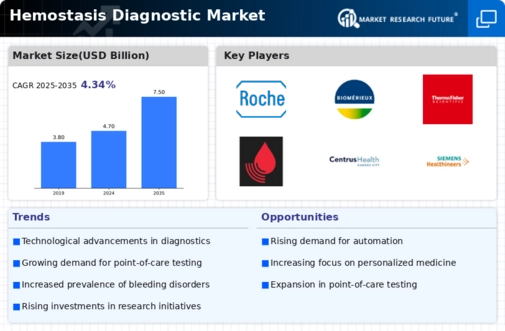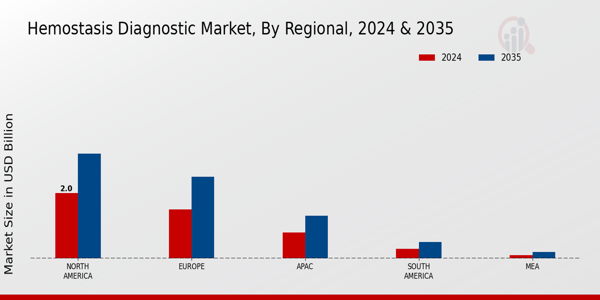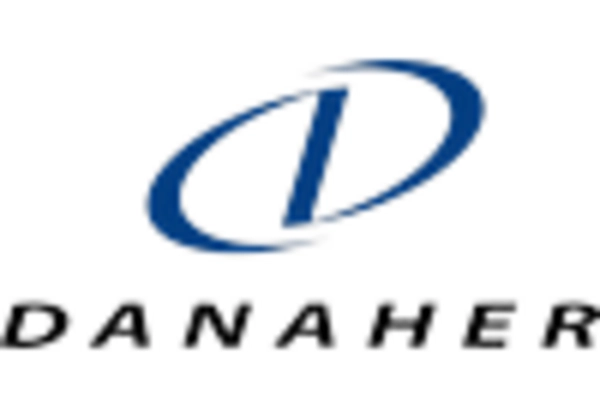Rising Incidence of Hematological Disorders
The increasing prevalence of hematological disorders, such as hemophilia and thrombosis, is a primary driver for the Hemostasis Diagnostic Market. According to recent data, the incidence of hemophilia is estimated to be around 1 in 5,000 live births, leading to a growing demand for effective diagnostic tools. As awareness of these conditions rises, healthcare providers are more inclined to invest in advanced hemostasis diagnostic solutions. This trend is further supported by the aging population, which is more susceptible to blood-related disorders. Consequently, the Hemostasis Diagnostic Market is likely to experience substantial growth as healthcare systems adapt to meet the needs of this demographic.
Regulatory Support for Diagnostic Innovations
Regulatory bodies are increasingly supporting innovations in the Hemostasis Diagnostic Market, which is fostering growth. Streamlined approval processes for new diagnostic technologies are encouraging manufacturers to invest in research and development. For instance, the introduction of expedited pathways for novel diagnostic tests is likely to accelerate the availability of advanced hemostasis solutions. This regulatory support not only enhances market entry for new products but also ensures that healthcare providers have access to the latest diagnostic tools. As a result, the Hemostasis Diagnostic Market is expected to benefit from a more dynamic and competitive landscape, ultimately improving patient care.
Technological Innovations in Diagnostic Tools
Technological advancements in diagnostic tools are significantly influencing the Hemostasis Diagnostic Market. Innovations such as point-of-care testing and automated analyzers enhance the accuracy and speed of hemostasis testing. For instance, the introduction of microfluidic devices allows for rapid testing with minimal sample volumes, which is particularly beneficial in emergency settings. The market is projected to grow at a compound annual growth rate of approximately 6.5% over the next few years, driven by these innovations. As healthcare providers seek to improve patient outcomes, the demand for cutting-edge diagnostic technologies is expected to rise, further propelling the Hemostasis Diagnostic Market.
Increased Investment in Healthcare Infrastructure
The expansion of healthcare infrastructure is a crucial factor driving the Hemostasis Diagnostic Market. Governments and private entities are investing heavily in healthcare facilities, particularly in developing regions. This investment is aimed at enhancing diagnostic capabilities and improving patient care. For example, the establishment of specialized laboratories equipped with advanced hemostasis testing technologies is becoming more common. As healthcare systems evolve, the demand for reliable and efficient diagnostic tools is likely to increase. This trend suggests a robust growth trajectory for the Hemostasis Diagnostic Market, as more facilities adopt sophisticated diagnostic solutions to meet rising patient needs.
Growing Awareness and Education on Blood Disorders
There is a notable increase in awareness and education regarding blood disorders, which is positively impacting the Hemostasis Diagnostic Market. Campaigns aimed at educating both healthcare professionals and the public about the importance of early diagnosis and management of hemostatic disorders are gaining traction. This heightened awareness is likely to lead to increased testing and diagnosis rates, thereby driving demand for hemostasis diagnostic products. Furthermore, educational initiatives are fostering collaborations between healthcare providers and diagnostic manufacturers, which may enhance the availability of innovative testing solutions. As a result, the Hemostasis Diagnostic Market is poised for growth as awareness continues to expand.



















Leave a Comment